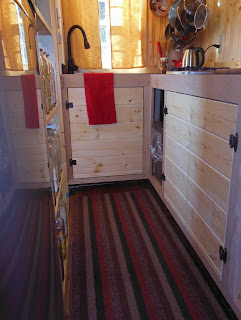Let us assume that you dream of owning a 20-24 ft tiny home that includes all the typical needs of a family. This includes sleeping areas, kitchen, bathroom, and living area. If you are a single person or a couple, most likely you will need one sleeping area. Larger families with children will need additional sleeping areas.
The kitchen and bathroom for a single person or a family can be the same size. The living area can also be the same size but will need more seating for larger families.
Here we are dreaming again without knowing if this life will fit our needs. I do not want to see families uproot and invested in a lifestyle that will not fit their needs and desires. So, how do we separate human desires from reality. I suggest folks simulate the tiny life in their current home. It would be difficult to exactly simulate tiny life because it is not possible to move the kitchen and bath in a conventional home without difficulty. However, you can set aside a living/sleep space in your home. Say, the master bedroom becomes your new tiny house.
Let us assume that your master bedroom is not huge, maybe 10 ft by 14 ft. For the next three months, this is your living space. Take everything out of the space that you will not move into your tiny house and store in another room in your home. Only have the items in your bedroom that you will move to the tiny house. Now, except for bathroom and kitchen duties, store and live completely in this space. You can build a platform for a bed and put a desk under to increase your living space. Other items can be constructed to maximize the usefulness of this space.
This is not as easy as it sounds. For example, when you come home from work, put your shoes and jacket in your simulated tiny house, not by the front door. Develop a new mindset, the rest of the house does not exist, it is only a passageway. Absolutely everything you need for daily living must go in your simulated tiny house (your bedroom) except bath and kitchen items.
In the kitchen, box up everything that will not move to the tiny house. The big mixer, all the extra plates and cups, extra silverware, multiple sets of pots and pans, etc. Also box up all the gadgets that you will not have space for in your tiny house. Now, each time you cook, only use the items you have not packed. If you decide you need something that is in storage, you can retrieve it but it now stays in your kitchen. It will move to the tiny house.
If you have a typical side-by-side refrigerator (approximately 20-25 cu ft), do not use a couple shelves and do not use half of the freezer. In a tiny house, the typical refrigerator is 10 cu. ft or less. Can you live with less refrigerator space? You must be very strict with yourself. If you order a pizza and have leftovers, you can not use one of the empty shelves to store the pizza till tomorrow-that shelf will not exist in your new tiny house. Below is my 9.9 cu ft apartment refrigerator for my tiny house. It is plenty for my needs, will it be sufficient for your family?
In your bathroom, use the same techniques. Box up everything that will not go to the tiny house. All the makeup, shampoos, storage boxes, etc. Only have the items you will move to the tiny house in your bath. Also, turn off the toilet by turning the water off. Use a composting toilet, either a bucket or get a conventional commercial composting toilet (like the Nature's Head). If this experiment does not work, you can sell the composting toilet and your losses will be much less than if you have completely jumped into tiny life in a tiny home.
Try this life for at least three months. Then sit down and analyze your successes and failures. Were you honestly able to live in the space you set aside or were you expanding into the other spaces of the house. Big question: did you thrive with this new paradigm. Three months is long enough so that it does not feel like camping. If you enjoyed living in this tiny space, you were honestly able to live in this space and you still want to live this way, then it is truly time to move forward to the tiny life.
If not, this is not a failure; maybe you learned that you can downsize from your 2500 sq. ft home to 1000 sq ft. Maybe you learned that this is not the life for you and your family. Or just maybe, you have found the lifestyle that truly fits you needs, the tiny life. If so, them most of your downsizing is finished. All the items stored (except the items in the bedroom, kitchen and bath) will need to be discarded, sold, re-purposed, given away or put into storage. I wish you success in your trial.
During my transition, I found this book very useful.





Moose
ReplyDeleteA few days ago you mentioned a few dvds could you tell me what those were again. I've been searching Facebook for them but can't seem to find the post.
Thanks for being so awesome!!
Hello Jennifer, if you look on the right hand side of my blog, you will see a link to the DVD set ("recommended DVD set"). I watched this DVD set so many times I wore out the first DVD. I will do a review of this DVD set but it will not be for another couple weeks.
ReplyDelete